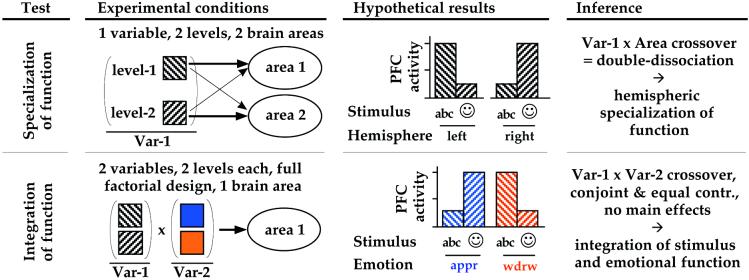Figure 1.
Two formal tests of brain functional organization based on neuroimaging data used in this paper. A variable represents a psychological function (e.g., working memory); levels of a variable represent subfunctions (e.g., verbal, nonverbal). The form of the observed interaction is critical (crossover or not), but the direction is not. (Upper) A test for specialization assesses whether a psychological function must be separable into subfunctions, on the basis of a double-dissociation by area (see ref. 4). The null hypothesis is that the function is unitary, and fractionation is not possible; this is falsified if there are two distinct brain areas for which processing associated with one subfunction activates area1 but not area2, and processing associated with the other subfunction activates area2 but not area1. That is, a Function × Area (e.g., Stimulus × Hemisphere) crossover interaction shows that the two subfunctions are distinct or separable for at least one point of processing. (Double-dissociations can also be shown in the time domain.) (Lower) A test for integration assesses whether two psychological functions must be inseparable within some brain region. The null hypothesis is that two functions (e.g., working memory and emotion) are completely separable. This is falsified if there is at least one brain area in which activity (i) is not predictable given only information about either function in isolation, and yet (ii) is influenced conjointly and equally by the two functions in combination; i.e., in a full factorial design, there are no main effects of either function and yet there is a Function1 × Function2 crossover interaction (e.g., Stimulus × Emotion). These conditions and results are sufficient to show integration: If the pattern holds, integration must be occurring; without the pattern, no inference about integration can be drawn. The locus where integration is revealed is not necessarily the locus where it occurred: it could be revealed at a point of processing that is subsequent to, yet correlated with, its actual occurrence. abc, verbal stimuli;  , nonverbal stimuli; appr, approach-related; var, variable; wdrw, withdrawal-related.
, nonverbal stimuli; appr, approach-related; var, variable; wdrw, withdrawal-related.

